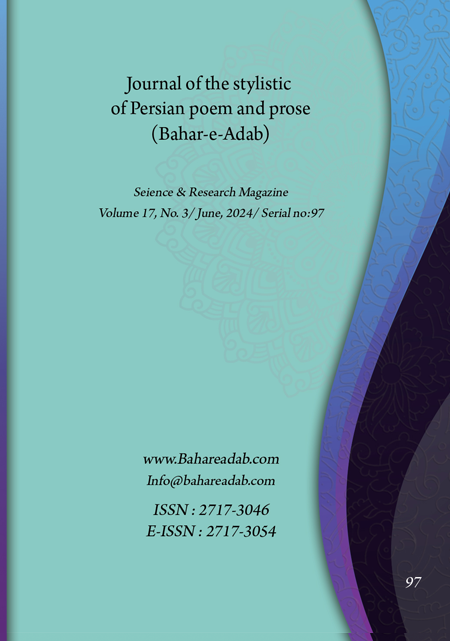- Count View : 241
- آدرس کوتاه شده مقاله: https://bahareadab.com/article_id/1663
- کد doi مقاله: Doi: 10.22034/bahareadab.2024 .17 .7080
Journal of the stylistic of Persian poem and prose
volume Number 17،
number In Volume 3،
،
issue Number 97
Investigating social realism in some Shahnameh stories
Shima Aadi , Manouchehr Akbari (Author in Charge)
Abstract
BACKGROUND AND OBJECTIVES: Reality is what we experience in our daily life, which can include personal or social issues. Social realism in ancient works can affect us in today"s life by the rituals and customs of the past. Therefore, in this research, by examining the social realism that has been carried out in the stories of the Shahnameh, we will achieve this important goal, which links the author of the Shahnameh, Ferdowsi, established between myths and reality, because on the surface, the cause of the events and actions is supernatural and unreal. It is said that while most of the narratives of the Shahnameh are based on the facts of life, the author in this research also examined the social events from the perspective of social, religious, political and cultural life in the Shahnameh.
METHODOLOGY: The present research is a theoretical study that was conducted as a library research. The main scope and society of the study was Ferdowsi"s Shahnameh, works and websites related to the research contents, after studying these works, the analysis and comments of the authors were included.
FINDINGS: In this research, we find that the foundation of most literary works is based on the reality of life, and the connection and similarity of the real manifestations contained in the Shahnameh corresponds to the social reality of our lives. Although the most artistic part of the Shahnameh is the mention of superhuman adventures, and apparently, at first glance, it does not fit with the reality and logic of our human life.
CONCLUSION: It is hard to believe the acceptance of many stories of the Shahnameh in concrete human life. Although Ferdowsi"s Shahnameh has a mythical and unreal appearance; But in its heart it has preserved the roots of reality. It can be said that the Shahnameh is based on the facts of life, and not only the facts of the life of the Iranian community, but the facts of human life.
Keyword
Shahnameh
, myth
, social reality
, epic
, legend
, realism.
- Ahmadi. Habib and others (2012). Social representation of Ferdowsi's Shahnameh (examining the social-cultural identity of the Iranian family institution from Ferdowsi's point of view). Women in culture and art. Volume 4. Number 2. pp. 100-83.
- Rashid Mohassel. Mohammadreza (2003). A few points about Ferdowsi and Shahnameh. Persian language and literature magazine. University of Sistan and Baluchestan. Year. pp. 81-96. 11. suffering. Ahmad (2016). Eight articles (sociology in literature). Tehran: Asatir, p. 45.
- Rooh Al-Amini. Mahmoud (1989). Reflection of social stratification in Diwan Hafez. Social science letter. Number 2. pp. 191-208.
- Riahi. Mohammad Amin (1996). Ferdowsi: his life, thought and poetry. Tehran: New Design, p. 215.
- Farjad. Mohammad Hossein (2003). Examining Iran's social issues. second edition. Tehran: Asatir, p. 11.
- Kazazi. Mirjalaluddin (2012). ancient letter Edited and reported by: Mirjalaluddin Kazazi, vol. 6. Fourth edition. Tehran. Samt.
- Giddens. Anthony (2007). Sociology. Translation: Manouchehr Sabouri. Tehran: Nei Publishing, pp. 424-427.
- Lowenthal. Leo (2007). Critical approach in the sociology of literature. Translation: Mohammad Reza Shadero. Tehran: Ney Publishing, p. 129.
- Merten. Robert (2000). Sociology of social problems. Translation: Simin Tulabi. Tehran: Amir Kabir, p. 117.
- Meskoub. Shahrokh (2005). An introduction to Rostam and Esfandiar. fourth edition. Tehran: Scientific and Cultural Publications, p. 6.
- Ururai. Jafar (2009). Ritual of statecraft, leadership, politics and ambassadorship in Ferdowsi's Shahnameh. Master's thesis. Guided by: Mohammad Fuladi. Qom: Qom University, p. 37.
- Noldeke. Theodore (1948). Iran's national epic. Translation: Boghor Alavi. Introduction: Saeed Nafisi. Tehran: Tehran University Press, p. 48.
- Yousefi. Gholamhossein (1977). Leaves in the arms of the wind. Tehran. Birch, pp. 7-8.
- Islami Nadiishan. Muhammad Ali (2002). Iran and the world from the perspective of Shahnameh. Tehran: Amirkabir, pp. 109-110.
- Agha Hosseini. Hussein and Rabbani. Messenger (2004). An analysis of social issues in the first stories of the Shahnameh: the stories of Kiyomarth, Hushang and Tahmorth. The publication of the Faculty of Literature and Humanities of Bahoner Kerman University. New period. Number 15. Series 12. pp. 1-22.
- Bazrafkan. Homira and Rouhani. Ali (2010). Social representation in Ferdowsi's Shahnameh - a study of the formation and transformation of Iranian society in Ferdowsi's Shahnameh. Political Science and National Studies Journal. Number 44. pp. 72-49.
- Burger. Peter and Lukeman. Thomas (2019). Social construction of reality. Translation: Fariborz Majidi. fourth edition. Tehran: Scientific and Cultural Publications, p. 33.
- Hamidian. Saeed (2004). An introduction to Ferdowsi's thought and art. Tehran: Nahid, p. 94.
- Khageghi Motlagh. Jalal (2002). Old sayings: thirty sayings about Ferdowsi and Shahnameh. Try it, Ali Dehbashi. Tehran: Afkar, p. 111.
- Durkheim. Emil (2016). Basic forms of religious life. Translation: Bagher Parham. Sixth edition. Tehran: Center, p.

